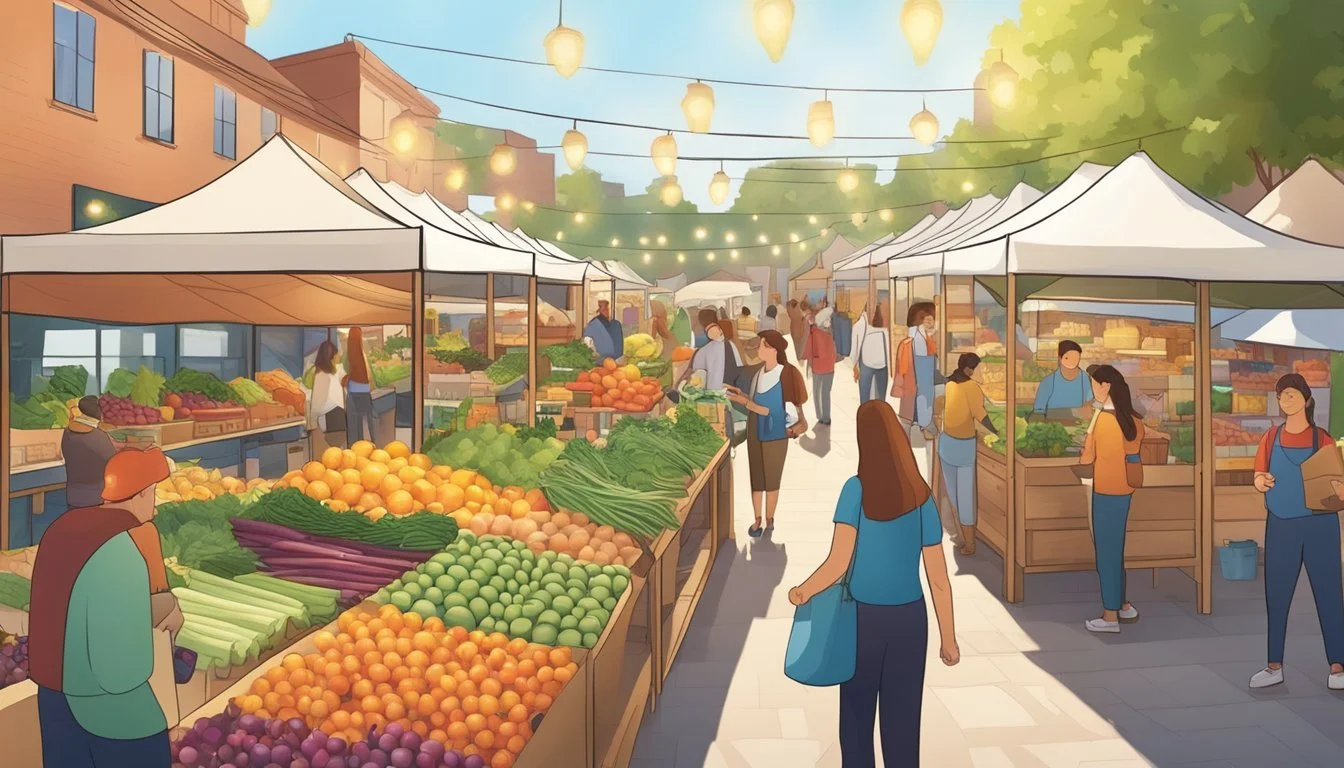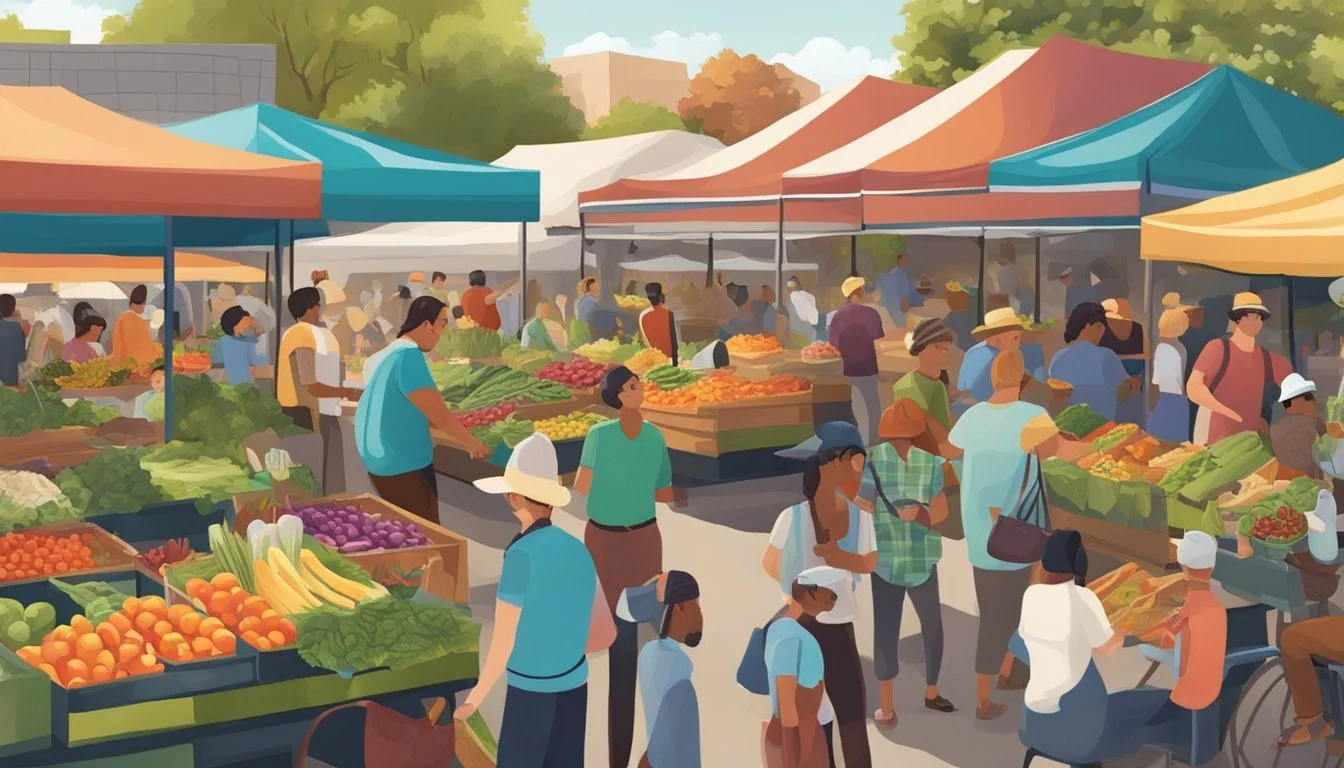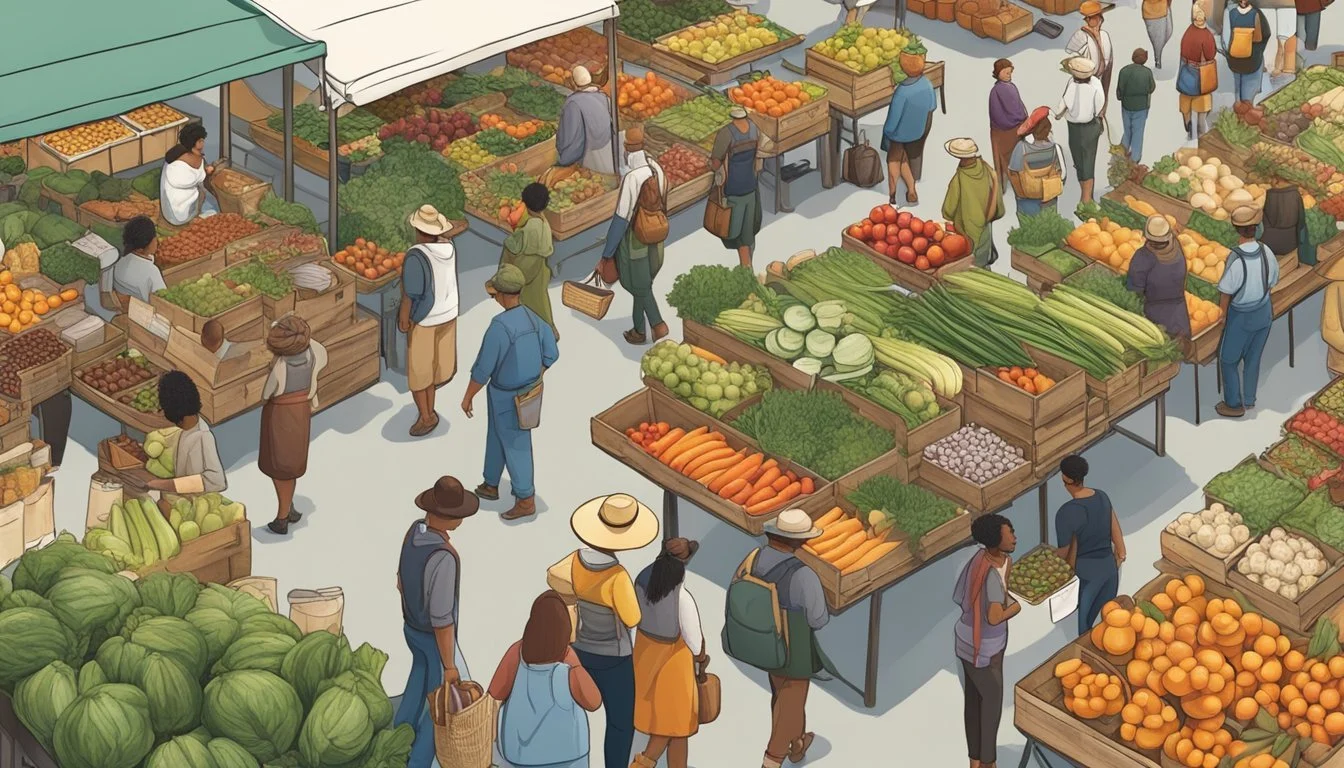The Future of Farmers' Markets
Navigating Evolving Consumer Preferences and Technology Advances
Farmers' markets have long been celebrated for their role in bringing fresh, locally-sourced produce to communities, but as innovative trends emerge in the agricultural sector, these traditional markets are undergoing a transformation. Sustainability has become a cornerstone for the future of agriculture, influencing consumer preferences and market dynamics alike. As agritech integrates into these markets, vendors are beginning to adopt new technologies such as IoT and AI to enhance the farm-to-table experience. These advancements not only streamline operations but also cater to the rising demand for transparency and food traceability among consumers.
The evolution of farmers' markets is further driven by the integration of digital platforms and precision farming techniques. Regenerative agriculture practices that focus on soil health and biodiversity are gaining traction, reflecting a shift towards more environmentally responsible food production. Additionally, markets are becoming hotspots for community engagement, offering educational opportunities about sustainable living and the importance of supporting local economies. With these shifts, farmers' markets are set to continue serving as pivotal connectors between rural producers and urban consumers, adapting to meet the challenges of a changing world.
Evolution of Farmers' Markets
Farmers' markets have a rich history that intertwines with the development of agricultural societies. Since the 1600s, these markets have played a crucial role in local economies, providing a venue for farmers to sell their produce directly to consumers.
The inception of farmers' markets in North America can be traced back to when they were essential spots for trade in city centers. Thomas Jefferson, for instance, was known to purchase staples like beef and vegetables at a Georgetown market in 1806. This personal interaction between farmers and consumers not only supported local economies but also allowed for the selling of fresh, local produce directly from farm to table.
Over time, the dynamics of farmers' markets have evolved. The global population's growing focus on sustainability and the desire for local food sources have been prominent factors that shaped their trajectory. Farmers' markets now serve as critical access points for healthy, locally-sourced products. They contribute to sustainable food systems by reducing the carbon footprint associated with transportation and packaging of goods.
The digital age brought significant transformations as well. Vendors have increasingly adopted technology to meet consumer demands more efficiently. From online ordering systems to the use of social media for marketing, modern-day farmers are aligning with contemporary business practices to sustain their presence in the market.
Today, farmers' markets remain a vital aspect of the community, adapting to the changing needs of the global population and more informed consumers. They continue to offer a sustainable alternative to supermarkets, fostering a sense of community while underpinning local economies.
Technological Advances in Agriculture
In the dynamic landscape of modern agriculture, farmers and stakeholders are leveraging cutting-edge technology to enhance productivity and sustainability.
Digital Tools and Artificial Intelligence
The intersection of digital tools and artificial intelligence (AI) is crucial for making informed decisions in agriculture. Machine learning algorithms process vast datasets, generating insights for optimized planting schedules and crop rotation strategies. These technologies empower farmers with predictive analytics for weather patterns, pest infestations, and yield forecasting, leading to smarter, data-driven farming practices.
Drone and Sensor Integration
Drone technology, combined with high-resolution sensors, has brought a new dimension to monitoring and managing agricultural land. Drones equipped with sensors not only perform aerial surveys to assess crop health but also contribute to precision agriculture. They can identify areas that require interventions like targeted pesticide application, minimizing chemical usage. This precise identification helps maintain a balanced ecosystem and reduces operational costs.
Automation in Crop Management
Automation is transforming crop management by introducing advanced machinery that can sow, irrigate, and harvest with minimal human intervention. Smart tractors and harvesters, fitted with GPS and real-time data processing, ensure efficient field operations. This automation reduces labor dependency and enhances the consistency of tasks performed, increasing both quality and volume of the agricultural produce.
Sustainable and Regenerative Practices
Farmers' markets are increasingly embracing sustainable and regenerative practices, focusing on organic and local production, soil health, and strategic cultivation methods.
Organic and Local Production Trends
Organic farming has seen an upsurge in popularity, with a significant shift towards locally-sourced, chemical-free produce. This approach ensures sustainability and reduces carbon footprints due to decreased transportation needs. Moreover, consumers are drawn to the transparency of organic local production, understanding exactly where and how their food is grown.
Soil Health and Regenerative Techniques
Soil health is paramount in regenerative agriculture, as it underpins the long-term viability of farms. Techniques such as no-till farming and composting improve soil structure and fertility. Regenerative practices not only enhance the land's productivity but also sequester carbon, contributing positively to the fight against climate change.
Cover Crops and Crop Rotation Advantages
Farmers' markets benefit from regenerative techniques like cover cropping and crop rotation for several reasons:
Reduction in Soil Erosion: Cover crops protect against wind and water erosion by holding the soil in place.
Enhanced Soil Fertility: These practices increase biodiversity and nutrient levels, leading to more robust produce offerings at farmers' markets.
By investing in these sustainable practices, farmers' markets can guarantee a future where agriculture works in harmony with the environment, providing healthy and sustainable options for the community.
Market Dynamics and Consumer Preferences
As farmers' markets evolve, understanding the interplay between changing consumer demand and market dynamics is essential to foresee the direction in which these markets are headed. The influence of global trends on local markets and the balance between price sensitivity and food values consistently shape the landscape.
Shift in Consumer Demand
Consumer preferences at farmers' markets are increasingly leaning towards organic and sustainable products. They prioritize the origin and production methods of their food, often seeking items that support their values, such as environmental sustainability and local community welfare. As the global population becomes more health-conscious, consumer demand at these markets shifts towards produce that is not only fresh but also perceived as healthier and more ethically produced.
Impact of Global Trends on Local Markets
Global issues, such as climate change and economic fluctuations, have a tangible impact on farmers' markets. Local markets are not insulated from these broader trends, which often dictate the availability and diversity of products offered. For instance, a trend toward plant-based diets globally can lead to an increased variety of vegan options at local farmers' markets.
Price Sensitivity and Food Values
Despite a willingness to support local farmers and sustainable practices, consumers remain price-sensitive. The prices at farmers' markets are often viewed under the lens of value — consumers weigh the cost of organic and sustainably farmed produce against their budgets and perceived benefits. However, a significant segment of the market is willing to pay a premium for food that aligns with their ethical and dietary preferences.
Price Consideration: Value for money vs. support for local economies.
Organic Demand: Higher prices for organic products justified by health benefits and ethical considerations.
Sustainability: Willingness to invest in products with a lower environmental impact.
Policy, Regulation, and Industry Standards
The landscape of farmer's markets is increasingly shaped by government policy and regulatory frameworks, underpinning the safety, sustainability, and competitiveness of the food supply chain.
Government Involvement and USDA Guidelines
The United States Department of Agriculture (USDA) plays a critical role in shaping the future of farmers' markets through policy and regulation. They have announced a comprehensive approach to level the playing field for small- and mid-sized producers by addressing competition in agricultural markets. USDA guidelines are crucial in establishing fair market conditions and supporting the development of farmers' markets across the nation. Their efforts include finalizing rules under the Packers and Stockyards Act and implementing a framework to bolster the food system post-pandemic, which emphasizes the creation of better market opportunities for local farmers.
Food Safety and Regulation Impact
Food safety stands as a non-negotiable priority, with stringent regulations impacting how farmers' markets operate. Regulatory bodies enforce safety standards to ensure public health is not compromised through the sale and distribution of fresh produce. Compliance with these regulations is mandatory, and they cover a broad range of practices, from the handling and storage of items to the prevention of foodborne illnesses. Farmers' markets must adhere to local, state, and federal food safety laws, which are designed to protect consumers and maintain the integrity of the food supply.
Challenges and Resilience in Farming
Farming faces multifaceted challenges in today's shifting global landscape, including climate volatility, market pressures, and pandemic aftereffects. However, resilience strategies in agriculture are advancing, enabling farmers to navigate these complexities.
Response to Climate Change
The agricultural sector is adapting to climate change by integrating climate-resilient crops and practices. Resilience is further enhanced through diversification of crops and farming methods designed to withstand extreme weather events. Strategic planning and use of forecasts allow for preemptive adjustments, mitigating potential negative impacts.
Climate-Resilient Crops: Selection and adaptation to sustain productivity.
Diversification: Broadening the genetic and ecological variety of crops.
Forecast Utilization: Implementing predictive analytics for preemptive action.
Coping with Market Fluctuations
Farmers are increasingly exposed to market volatility, with shifts in commodity prices and trading environments. They utilize various tools to buffer against sudden economic changes, which might stem from regulatory alterations, trade wars, or unexpected global events. Mechanisms such as futures contracts and diversified sales channels, including direct-to-consumer approaches like farmers' markets, enhance economic resilience.
Futures Contracts: Locking in prices to mitigate risks of market swings.
Sales Channel Diversification: Exploring markets beyond traditional supply chains.
Pandemic Effects and Recovery Mechanisms
The pandemic demonstrated the critical need for robust systems in farming. As the world recovers from COVID-19, farmers are reassessing their strategies to anticipate similar future challenges. Improvement in the distribution network, investment in local supply chains, and integration of technology for better logistics can contribute to the sector's recovery and future readiness.
Supply Chain Investment: Strengthening local networks to reduce logistical weaknesses.
Technological Integration: Utilizing digital tools for efficiency and adaptability.
Economic Aspects and Financial Support
The economic vitality of farmers' markets is instrumental to the broader agricultural economy. They not only serve as critical sales outlets for farmers but also attract significant investments, offering favorable returns. Access to insurance and loans further underpin their financial sustainability.
Agriculture Investments and ROI
Farmers' markets represent a nexus of small-business growth and agricultural entrepreneurship. With total revenue in the United States once reported to be $711 million, the farmers' market sector is a thriving component of the local food movement. Investments in the sector are often met with a strong return on investment (ROI), due to an increasing consumer demand for locally-sourced produce and an overall growth in the local food economy. These markets act as business incubators for new agricultural ventures, which can subsequently scale their operations with the right financial support.
Insurance and Loans for Farmers
Insurance schemes play a pivotal role in mitigating risk for farmers. Market vendors frequently depend on crop and liability insurance to protect their businesses from the unpredictability of weather and other potential losses.
Loans, particularly those backed by government agencies like the USDA, are critical financial tools that enable market participants to sustain and grow their operations. Here are two key types of loans beneficial to farmers' market:
Operating Loans: Assists farmers in covering the immediate costs of running a farmers' market business, such as seeds and equipment.
Facility Loans: Helps in the development of physical market infrastructures to enhance the shopper's experience and expand the market's capabilities.
By offering these financial supports, the sector not only ensures the long-term viability of individual farmers and vendors but also reinforces the economic foundations of local communities.
Future Directions and Emerging Trends
Technological Innovation
Advancements in technology are crucial in shaping the farmers' markets of the future. Precision agriculture and sustainable practices will likely become prevalent, utilizing data analytics to optimize food production with minimal waste.
Sustainable Food Production
Sustainable methods will continue to be at the forefront of agribusiness trends, with a focus on reducing environmental impact. Crop varieties are expected to evolve, to better withstand climate change and reduce resource usage.
Agribusiness Growth
The agribusiness sector is set to expand, integrating technological innovation into traditional farming practices. This includes the usage of drones, AI, and IoT to enhance crop yields and market logistics.
Protein Sources
In the realm of protein, there's a shift towards plant-based and lab-grown alternatives. This responds to changing consumption patterns, with consumers increasingly seeking sustainable protein sources.
Consumer Preferences
Consumers' demand for local and responsibly grown products will influence farmers' markets. The rise of urban farming highlights the trend toward localization of food production.
Key Trends Impact on Farmers' Markets Technological Advancements More efficient and sustainable practices Crop Diversity Resilient varieties for changing climates Agribusiness Innovation Growth in logistics and market reach Sustainable Protein Sources Diversification of products offered Consumer Shifts to Localism Focus on community-based agriculture
The farmers' markets of the future are likely to embody a blend of tradition and innovation, adapting to meet modern-day challenges while catering to informed consumer preferences.








